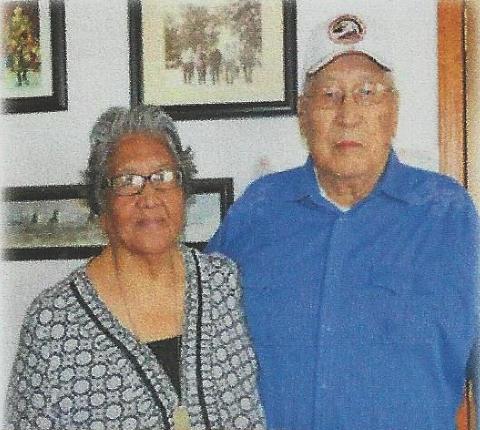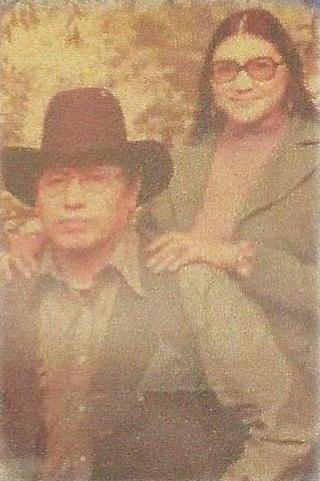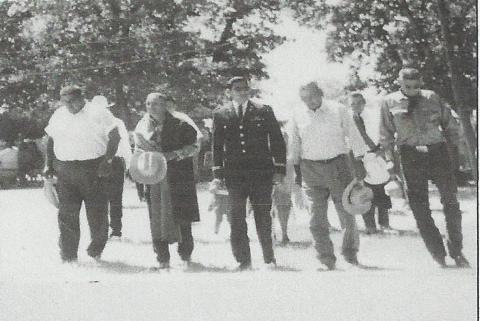 |
Canku Ota
|
 |
|
(Many Paths)
|
||
|
An Online Newsletter
Celebrating Native America
|
||
|
October 2015 - Volume
13 Number 10
|
||
|
|
||
|
Arapaho Elder Carries
Songs, Traditions And Love Of Family
|
||
|
by Rosemary Stephens,
Editor-in-Chief
|
||
Sitting down with 84-year-old Saul Birdshead Jr., Arapaho, and his wife of almost 40 years, Lavera, one is immediately drawn into their spiritual connection with one another. It would be hard to write about one without the other because of this connection they both share. Evident by Saul's comment, "my life started in 1975 when I met my wife and we have been together ever since." Saul begins his story with his birth at the old Concho hospital in 1931. He and his family lived in Cantonment where his dad worked as a farmer. "My mother and father were Susie and Saul Sr., both Arapaho, my grandmother was Traveler and my grandfather was Scabby Bull. We rode horses all the time as we were growing up. Some people had saddles, but mostly we rode bareback, and all the rest of the people that lived around us all had horses and rode horses," he said. He remembers being one of the poorest people around there, but said they never went without food or things they needed.
"We would kill rabbits, squirrels, and we had a lot of chickens. We would eat the eggs and kill chickens to eat and we had a milk cow," Saul reflected. "We would all go fishing, hunting and any games that involved riding horses we would play. The horses were the only way for us to get around because we didn't have cars and I don't really remember when we got automobiles." He said there was a lot of prejudice in those days, "but it didn't seem to bother us too much. We didn't talk to those white people and they didn't talk to us, so we all got along all right. The ones that did talk to us we got along with them good, and they learned a lot from us, and we learned English from them, so there was no problems there." Saul's memories mostly revolved around riding horses and singing as a child. As a matter of fact, if you ask Saul what he loves the most, his answer would be his wife, family and singing. "I remember I was 8 years old when I first started singing. I used to play outside and had rocks I would pretend were cars, and I would be singing a song. When I would get to a spot where I didn't know it anymore I would stop and go in the house and tell my mother, 'sing that song.' I would tell her to sing that War Mother song because she was the chairman of the Canton War Mothers and she would sing it," Saul said. "I learned from her and I would start playing again, singing, and I would forget it and I would go back into the house and have her sing it again. That's how I learned to sing that way. Singing came easy to me." Saul said one of the main songs he learned was the Cheyenne Sundance song because they lived right in the, "Cheyenne Sundance area and when the Sundance was going on I would go over and sing. Once you get started singing and get used to it, it's easy to switch over and sing a different song." Life passed in Canton where Saul attended school until the 9th grade, then left to attend school in Kansas at Haskell until he graduated high school. He said immediately after he graduated he went into the U.S. Army. "That was the thing to do, join the military, I didn't even think about it, I just went into the service and retired after 23 years as a Chief Warrant Officer 3." It was here Saul became adamant that all anyone needed to know about his time in the service was he was over there (Korea) fighting for everyone.
"I was a Chief Warrant Officer 3 and worked on nuclear weapons. Most of the time I worked under the classification of top secret, people didn't know what I did they just knew I worked with nuclear weapons. It was nobody's business but ours. Basically we traveled a lot, went to a lot of places and it's not anyone's business what we done over there and why," Saul stated firmly. "I have never written down anywhere I have been or anything I did in the Army. All people need to know is I was fighting for you and you and everybody else and that's all they need to know … and I left as a Chief Warrant Office, CW3, so I must of done a pretty good job." Saul laughed, breaking the serious overtones that had taken over the conversation. After retiring, it was then in 1975 that he met his wife Lavera and it was love at first sight. "I knew her folks and brothers and one day I came over here to Apache and she came over … I took one look at her and said to myself, 'man that girl is cute, beautiful girl.' I asked her, 'how old are you' and she said, 'I'm old enough.' She wouldn't tell me and I thought man I might get into trouble here cause she looked too young, like 15 or 16 years old," Saul laughed. "I guess she was older than that, she was about 20, and I took a chance and said come on let's go and we have been together ever since then. Forty years Oct. 25 and we have three children." Their oldest daughter, Susan works at Comanche Memorial Hospital, second daughter Jennifer, works in Washington, D.C., and their youngest is their son Nicolas, Army veteran, who works as an IT person at the University of Oklahoma (OU). Both Saul and Lavera's eyes lit up when they began to talk about their three children and their seven grandchildren. "We have the Arapaho Sundance, the way we worship, and all the kids come when we have that every year and another way we worship is here in Apache, the Dance of the Mountain Gods and they all come home for that," Lavera shared. Saul waited for Lavera to finish sharing about their family then said he had been married to one other woman, before Lavera's time, and they had had three children together, all of whom had died of alcoholism. "After Lavera and I had our three kids, I would take our kids, as they were growing up, over there to visit my other three kids and I would tell them this is what alcohol will do to you if you drink … you know it must of stuck with them because none of them drink and I don't even think they smoke. They remember seeing how sick those other three were before they passed away," Saul said. Stopping for a minute, Saul watched as Lavera rose and brought glasses of tea to the kitchen table. He reached over as she sat back down and gently touched her hand as he turned his attention back to the interview. "One of the good things about me and my life, I mean I have a lot of good things in my life, but one of them is I am a singer. I am an Arapaho singer and as far as I am concerned I am one of the best Arapaho singers, Northern and Southern Arapaho. Yes, so I would just say I am an Arapaho singer. I make Arapaho songs that have words in them," Saul's excitement about singing was showing in his face as he continued. "The reason why these others don't is because they don't know how to speak Arapaho, so they can't put any words into their songs. When we sing the songs that I sing with Arapaho words in them, I always tell these guys when I sing these songs, you sit with me and you learn that way." He reflected back and said it was after coming out of the military he was singing Northern Arapaho songs back then when a friend of his from Lame Deer, Montana, Phillip Whiteman sent him two tapes and said he wanted him to learn the tapes. "There were Arapaho songs and that's where I learned to sing those songs. Before I would sing all the different tribes' songs when I first started singing." He said an old man in Washington State told him once, "you are a good singer. You sing good, always sing, every chance you get, sing your songs. Sing our songs, different ones. When you do that you sing good and if you will do that, then all these different singers are going to ask you to sing with them." Saul said that's what he did. He sang songs from the Pine Ridge people and a lot of others. "I used to dance too, was pretty good and won a lot, but when that got too hard I just started singing, which was easier, so that's mostly what I do. I danced Traditional because you dance kind of slow and it's a lot easier to dance that way than the Fancy dance. I used to dance Fancy when I was able to do that, but after a certain age I switched to Traditional," Saul said. "But now I like to sing. I teach my grandkids and relatives, I teach them how to sing. The way I teach them is I tell them when I go sit at that drum I am going to sing and if you want to learn then come sit by me and sing. That way you will learn how to sing those words." Saul said he can still remember he was just starting to sing the Southern way when Arapaho Chief, Willie Hail, "which they had made me an Arapaho Chief in 1971, but anyway he told me, 'Junior', that's what they called me. 'Junior we need you to sing Arapaho songs because when you sing Arapaho songs these fellas are going to sit with you and they are going to learn from you. We need you to do that, so starting now you sing Arapaho songs.' And that's what I have been doing ever since." Saul even received a grant funded by the National Endowment of the Arts to tape as many Arapaho songs as he could.
Lavera, who had been silently sitting and listening leaned over after Saul paused and said, "When he first started Willie Hail said all their singers were dying out and that's why they got him to do that and he got that grant to sing and record the songs. And now there are at least 30 that can sing those songs. Saul recorded not only those songs but Sundance songs, Sweat songs, Flag songs and even talked about how to build a sweat." Saul said it was a good thing to see and be a part of younger generations learning the songs, "They still do it that way, sit with us to learn the songs and when I am not there they still will sing these songs. It's a good thing to see and be a part of. The songs can be carried on, when I am gone and I am not here, they can all carry on the songs, and we have some beautiful songs as Arapahos, and Cheyenne." Saul smiled over at Lavera and said, "Lavera, too, will be sitting somewhere behind us singing with us. Sometimes when we are singing she does that now, go stand behind the drum and sing and that's something you see a lot of nowadays, women sitting out there with the drum singing the same song … it's a good thing." Saul took a moment and began to gently tap the top of the kitchen table as if it were a drum and in a serenely deep voice began to sing an Arapaho Flag song. As he sang, Lavera began to join in, singing in a softer quieter tone. "That's a song I made, the words in there are talking to you. It is saying my friends, my relatives, look up there, look at this flag as it is waving, and the wind is causing it to blow … it is a good song," Saul said. Sitting quietly for a few moments, Lavera and Saul both agreed a lot of things happen between them and the Spirit, though they don't ask for these things to happen, they just do. They said a lot of times they don't sit down and hold hands and pray together, but they are always spiritually connected and they always agree in the spirit. They have story after story of miracles that have occurred in their lives and both know that if they hang on to one another and stand firm in their faith and trust, that every time, in every situation, everything will work out. And that's how, at 84 years of age, Saul Birdshead Jr., continues to live his life. |
|||||||
|
|
|
|
||
|
|
||
| Canku Ota is a free Newsletter celebrating Native America, its traditions and accomplishments . We do not provide subscriber or visitor names to anyone. Some articles presented in Canku Ota may contain copyright material. We have received appropriate permissions for republishing any articles. Material appearing here is distributed without profit or monetary gain to those who have expressed an interest. This is in accordance with Title 17 U.S.C. Section 107. | ||
|
Canku Ota is a copyright ©
2000 - 2015 of Vicki Williams Barry and Paul Barry.
|
||
 |
 |
|
|
The "Canku
Ota - A Newsletter Celebrating Native America" web site and
its design is the
|
||
|
Copyright ©
1999 - 2015 of Paul C. Barry.
|
||
|
All Rights Reserved.
|
||



